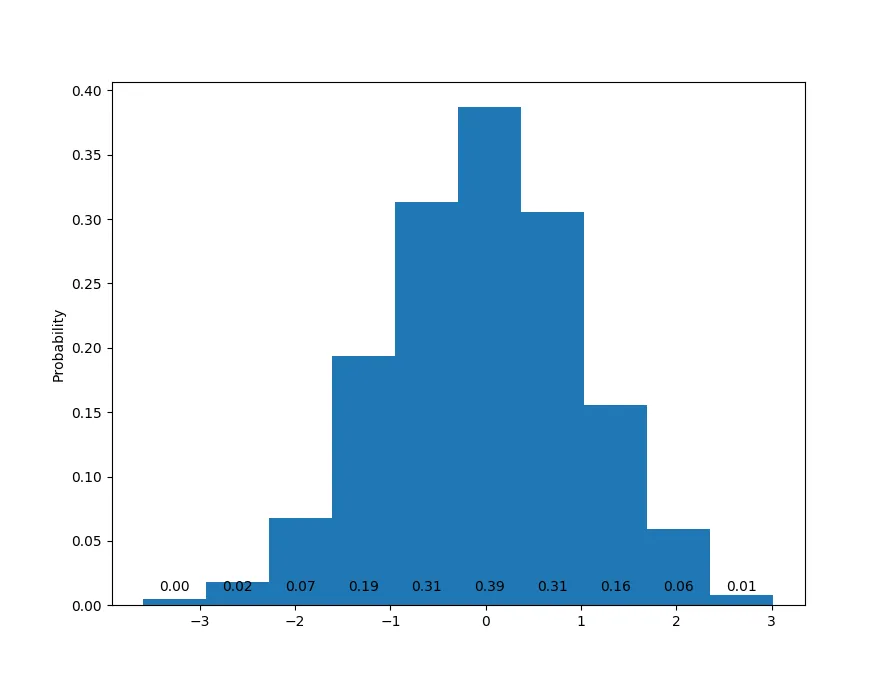请您好,我认为我的问题很简单,但我找不到任何有用的博客来展示如何实现。我有一个名为“series”的Python Pandas系列,并使用series.hist()来可视化直方图。我需要在图表上直接可视化每个bin的出现次数,但我找不到解决方法。
我该如何在每个bin上面看到显示每个bin的出现次数的标签呢?
要确切,请看我的代码:
import matplotlib.pyplot as plt
your_bins=10
data = [df_5m_9_4pm.loc['2017-6']['sum_daily_cum_ret'].values]
plt.hist(data, binds = your_bins)
arr = plt.hist(data,bins = your_bins)
for i in range(your_bins):
plt.text(arr[1][i],arr[0][i],str(arr[0][i]))
如果我只是打印变量"data",它的样子就像这样:
[array([ 0. , 0.03099187, -0.00417244, ..., -0.00459067,
0.0529476 , -0.0076605 ])]
如果我运行上述代码,会出现错误消息:
---------------------------------------------------------------------------
ValueError Traceback (most recent call last)
<ipython-input-97-917078981b1d> in <module>()
2 your_bins=10
3 data = [df_5m_9_4pm.loc['2017-6']['sum_daily_cum_ret'].values]
----> 4 plt.hist(data, binds = your_bins)
5 arr = plt.hist(data,bins = your_bins)
6 for i in range(your_bins):
~/anaconda3/lib/python3.6/site-packages/matplotlib/pyplot.py in hist(x, bins, range, density, weights, cumulative, bottom, histtype, align, orientation, rwidth, log, color, label, stacked, normed, hold, data, **kwargs)
3002 histtype=histtype, align=align, orientation=orientation,
3003 rwidth=rwidth, log=log, color=color, label=label,
-> 3004 stacked=stacked, normed=normed, data=data, **kwargs)
3005 finally:
3006 ax._hold = washold
~/anaconda3/lib/python3.6/site-packages/matplotlib/__init__.py in inner(ax, *args, **kwargs)
1708 warnings.warn(msg % (label_namer, func.__name__),
1709 RuntimeWarning, stacklevel=2)
-> 1710 return func(ax, *args, **kwargs)
1711 pre_doc = inner.__doc__
1712 if pre_doc is None:
~/anaconda3/lib/python3.6/site-packages/matplotlib/axes/_axes.py in hist(***failed resolving arguments***)
6205 # this will automatically overwrite bins,
6206 # so that each histogram uses the same bins
-> 6207 m, bins = np.histogram(x[i], bins, weights=w[i], **hist_kwargs)
6208 m = m.astype(float) # causes problems later if it's an int
6209 if mlast is None:
~/anaconda3/lib/python3.6/site-packages/numpy/lib/function_base.py in histogram(a, bins, range, normed, weights, density)
665 if mn > mx:
666 raise ValueError(
--> 667 'max must be larger than min in range parameter.')
668 if not np.all(np.isfinite([mn, mx])):
669 raise ValueError(
ValueError: max must be larger than min in range parameter.

data打印来看,似乎您已经将数据封装在一个列表中 - 因此,您正在传递一个数组的列表而不是值的数组。请尝试改为plt.hist(data[0], bins = your_bins)。或者更好的方法是在分配data时删除括号。 - Patrick O'Connor